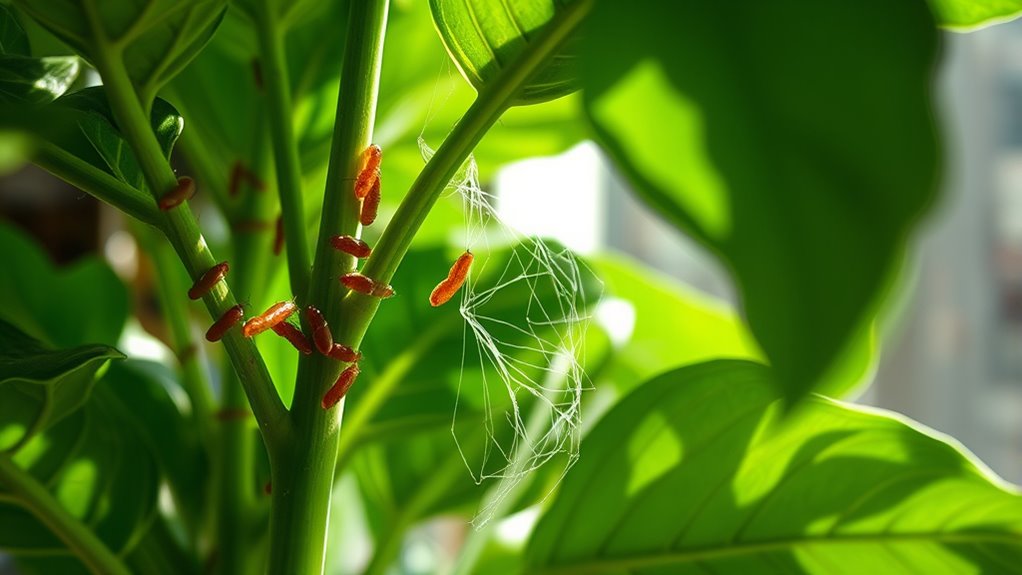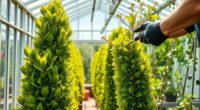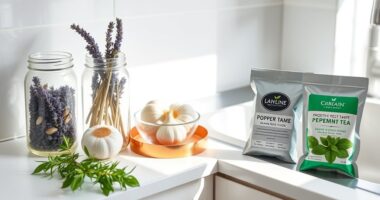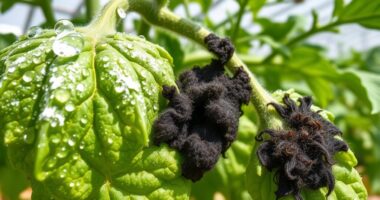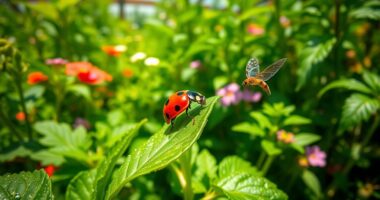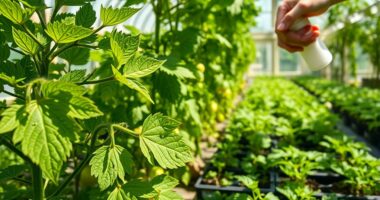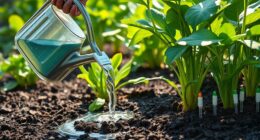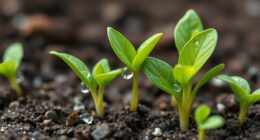If you discover a pest infestation, act quickly by isolating the affected plants in a separate area away from healthy ones. Remove heavily infested parts and use physical barriers like screens or sticky traps. Adjust environmental conditions to inhibit pests and consider targeted treatments such as insecticidal soap or neem oil. Keep a close eye on your plants and maintain hygiene to prevent spreading. Continuing will help you understand more effective steps to protect your garden.
Key Takeaways
- Immediately isolate infested plants in a separate area to prevent pest spread.
- Use physical barriers, sticky traps, and environmental adjustments to inhibit pest activity.
- Regularly inspect plants and remove heavily infested parts or entire plants if necessary.
- Apply targeted treatments like insecticidal soap or neem oil following safety guidelines.
- Maintain strict hygiene and monitor regularly until pests are fully controlled before removing quarantine.
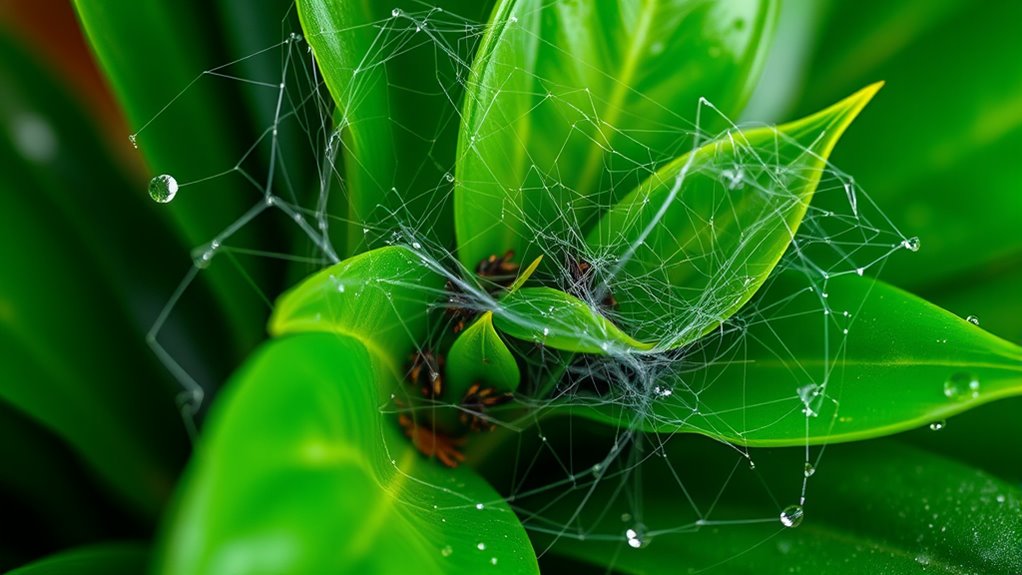
Plant infestations can quickly threaten local ecosystems and agriculture if not controlled promptly. When you notice abnormal changes in your plants—such as discolored leaves, wilting, or unusual pests—you need to act swiftly to prevent the spread. The first step is accurate pest identification. Recognizing what kind of pest is invading your plants helps determine the most effective control methods and whether quarantine procedures are necessary. Take a close look, and if you’re unsure, consider consulting local extension services or using online resources with detailed images and descriptions.
Early pest detection is key to protecting your plants and preventing damage.
Once you’ve identified the pest, it’s essential to implement quarantine procedures immediately. Isolate the infested plants away from healthy ones, ideally in a separate room or outdoor area with restricted access. This prevents pests from migrating to other plants and causing further damage. During quarantine, inspect nearby plants regularly for signs of infestation. Keep tools, gloves, and any equipment used on infected plants separate to avoid cross-contamination. You might also want to think about removing heavily infested plant parts or entire plants if they pose a risk of spreading pests further.
Proper quarantine procedures also involve controlling the environment around your plants. Adjust humidity, temperature, and light levels to discourage pest proliferation. For example, some pests thrive in moist, warm conditions, so reducing humidity and increasing airflow can help inhibit their growth. Be vigilant for signs of pest movement or new infestations during this period. Using physical barriers like insect screens or sticky traps can further help contain the pests and monitor their activity. Additionally, implementing noise levels of pest activity monitoring can assist in early detection and control efforts.
While quarantine is an essential initial response, it’s often not enough on its own. You’ll need to complement it with targeted pest control measures, such as insecticidal soaps, neem oil, or other appropriate treatments based on the pest type. Always follow label instructions carefully and consider the safety of beneficial insects and the environment. Regular monitoring during and after treatment ensures that the infestation is truly under control.
Frequently Asked Questions
How Long Should I Quarantine New Plants Before Introducing Them?
When you bring new plants home, it’s crucial to take plant transfer safety into account. Quarantine duration typically lasts at least 2 to 4 weeks, giving you enough time to observe any signs of pests or diseases. During this period, keep the plants separate from your existing ones and monitor them closely. This careful plant transfer helps prevent potential infestations and ensures your healthy plants stay safe.
Can Quarantine Procedures Prevent All Types of Plant Infestations?
You might think quarantine procedures can stop all pest invasions—think again! While pest identification and using the right quarantine materials dramatically reduce risks, no method guarantees total protection. It’s like putting a giant shield around your plants, but tiny pests sometimes slip through. Still, diligent quarantine steps give you the best shot at catching problems early and saving your plants from devastating infestations. Stay vigilant!
What Are the Signs That Quarantine Failed?
If your quarantine failed, you’ll notice signs like new plant disease symptoms or pests appearing despite your efforts. You might see continued pest activity or fungal spots developing on your plants. These signs mean pest prevention methods didn’t fully work, and infections may spread. Regularly check quarantined plants for any changes, and act quickly to contain issues, ensuring your quarantine process effectively protects your other plants from infestations.
Should I Discard Plants That Show Early Infestation Symptoms?
Imagine spotting early infestation symptoms—do you risk quarantine failure or save your plant? You should consider pest identification and quarantine duration before deciding. If pests are easily identified and quarantine is strict, you might salvage the plant. But if symptoms worsen or pests resist treatment, discarding could be the safest choice. Trust your judgment, stay vigilant, and remember, sometimes letting go preserves the whole garden’s health.
How Often Should I Inspect Quarantined Plants?
You should inspect quarantined plants at least twice a week. Regular pest identification helps catch issues early, preventing the infestation from spreading. Keep a close eye on the quarantine environment, checking for new signs of pests or symptoms. Consistent inspections guarantee you catch any problems quickly, allowing you to take prompt action and protect your healthy plants from potential pests. Staying vigilant is key to successful quarantine management.
Conclusion
Protect your plants, prevent the pests, and preserve your peace of mind. Quarantine quickly, treat thoroughly, and monitor regularly. Stay vigilant, act promptly, and stay committed. By taking these steps, you safeguard your garden, save your plants, and secure your enjoyment. Remember, early action makes all the difference—quarantine, treat, and watch over your plants diligently. Keep them healthy, keep them thriving, and keep your gardening joy alive.
